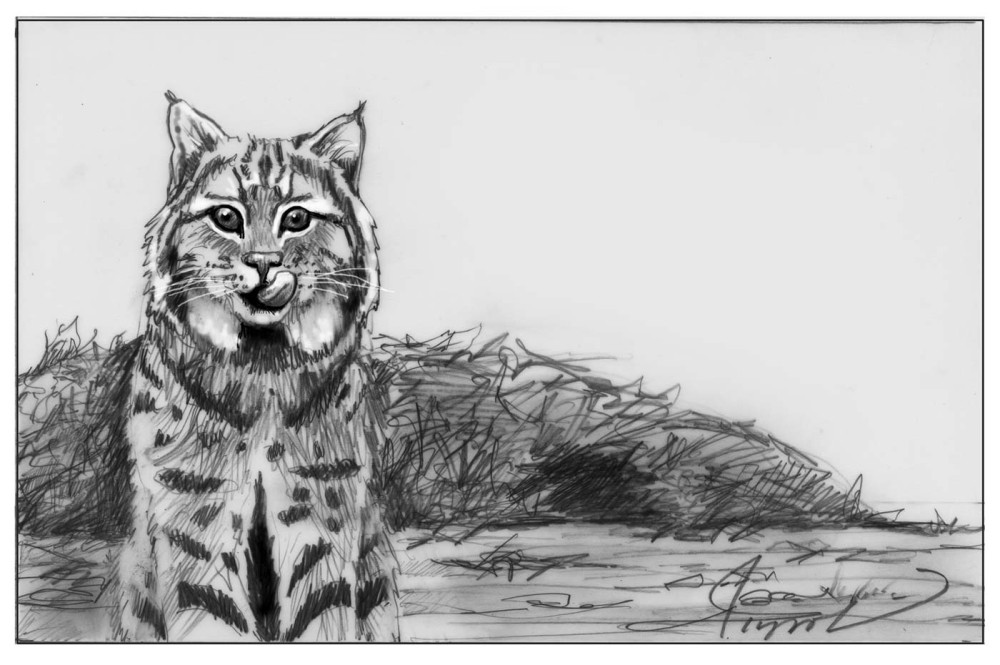
On a cold November 2020 day, my daughter Lucy and I detected a strange floral scent in our woods. I challenged her to find its source, and promised a reward of chocolate cake. After some sniffing, she led the way several feet upslope, stopping at a rotting log which bridged the air between two boulders.
“Here.” she said.
“Here” was a recent urine marking. Beneath the log was another clue: a pile of leaves mixed with hair that had been sheared with scissor-like bites. I use a stick to push back some of the leaves, revealing the shoulder of a deer.
“Your dad,” I said, “is going to lose his mind over this.”
So began our family’s winter bobcat cache adventure. Lucy and her brother got a chocolate cake. And my husband Tig did, in fact, go cat-mad, setting up an elaborate system of homebrewed infrared triggers and no-flash digital cameras. Through these cameras, we spied on the cats over the next several months as they visited three separately cached deer. In March, friends alerted us to a fourth cache, this time of a road-killed deer on the edge of their property. Tig set up cameras there, too, and once again we discovered that two different bobcats were visiting the cache together.
It was a fun, fascinating and occasionally grisly project, which prompted many questions. How could an animal not much bigger than a domestic housecat take down hundred-plus pound deer? And why, despite their reputations as solitary animals, were bobcats consistently visiting these sites in pairs?
Patrick Tate, a wildlife biologist with the New Hampshire Fish and Game Department who has studied bobcats for many years, said that he has never found anything other than deer in bobcat caches. Bobcats can consume most other prey, such as squirrels, in one meal. Caching is most common during winter, when food is scarce and the cats are more willing to risk attacking dangerous prey. Female cats, which rarely weigh more than 20 pounds, are less likely than the larger males to hunt deer, which explains why male cats have more broken or missing teeth.
Tate correctly guessed that our caches were all on the southern side of our hill. In winter, deer often congregate on sunnier, south-facing slopes, he explained, so bobcats focus on that terrain. The cats are especially attracted to areas that are “messy,” for example, where logging or other forest disturbances have left stumps, downed trees, and other detritus that offer good ambush cover. Rocky ledges over deer trails are also favored hunting spots. A bobcat will wait out of sight, stalk and pounce. The struggle can be protracted, with high risks on both sides as the cat attempts to sink its canines into the deer’s throat. Tate recalled a kill site where “the deer ran 100 feet with the cat riding it, before it came down.”
After the bobcat feeds on the fresh carcass, it covers the remains with leaves, snow, and other loose material. It may also mark the site with urine, an act that presumably serves as a territorial signal – and that also seems at cross-purposes with food concealment.
Male cats often have overlapping territories with females, and they will sometimes allow females to share their kills. In addition to the obvious benefits of feeding potential mates, Tate said, there may be a defensive advantage. Coyotes, especially, pose a risk as cache raiders, but game camera evidence and hunter observations suggest that coyotes are less likely to challenge a bobcat pair than a solitary animal. (Of course, nothing prevents the coyotes from raiding the site in between bobcats’ visits.)
After reviewing Tig’s photos, Tate confirmed that our friends’ cats were indeed an adult male and young female. I was gratified however to learn that our own cats were a mother and juvenile kitten, defying the gender norm for cache sites. Perhaps there was a male who was sharing his caches with a mother and kitten, but evading our cameras? Or maybe, as I prefer to believe, we have an exceptionally skilled huntress living in our woods.
We still have many questions, and much to learn, about our feline neighbors. We didn’t find any caches this winter, but we saw many bobcat and deer tracks, so we’re holding out hope for next year.


Discussion *